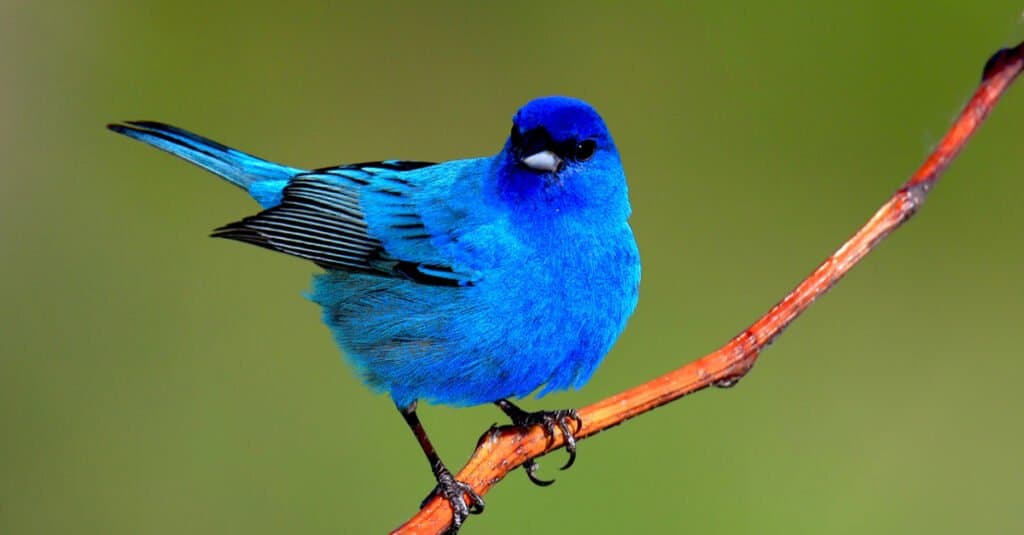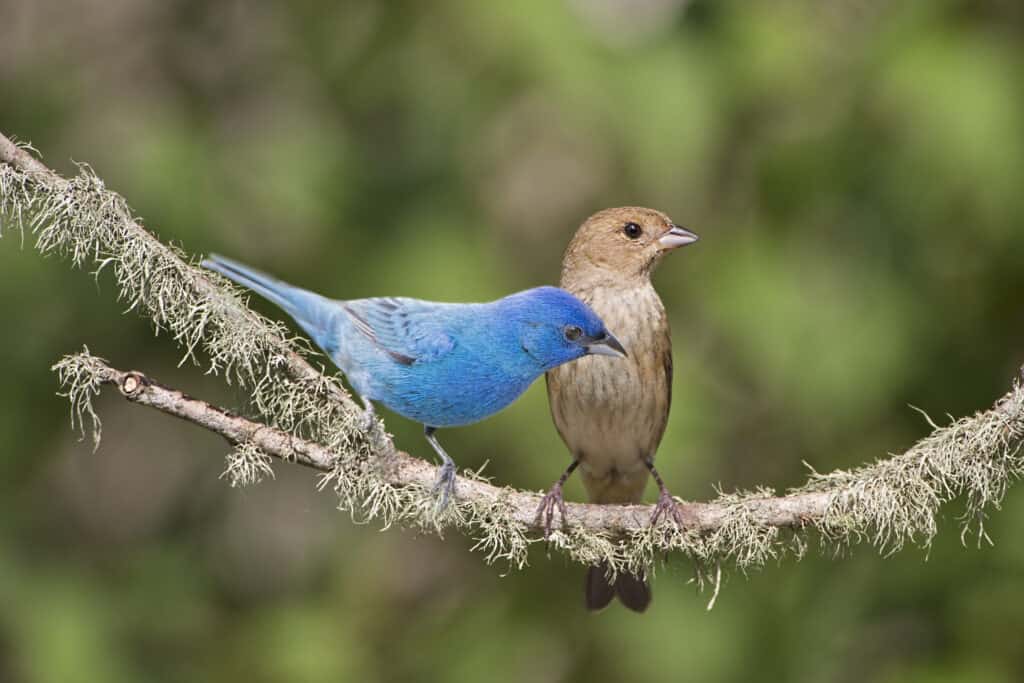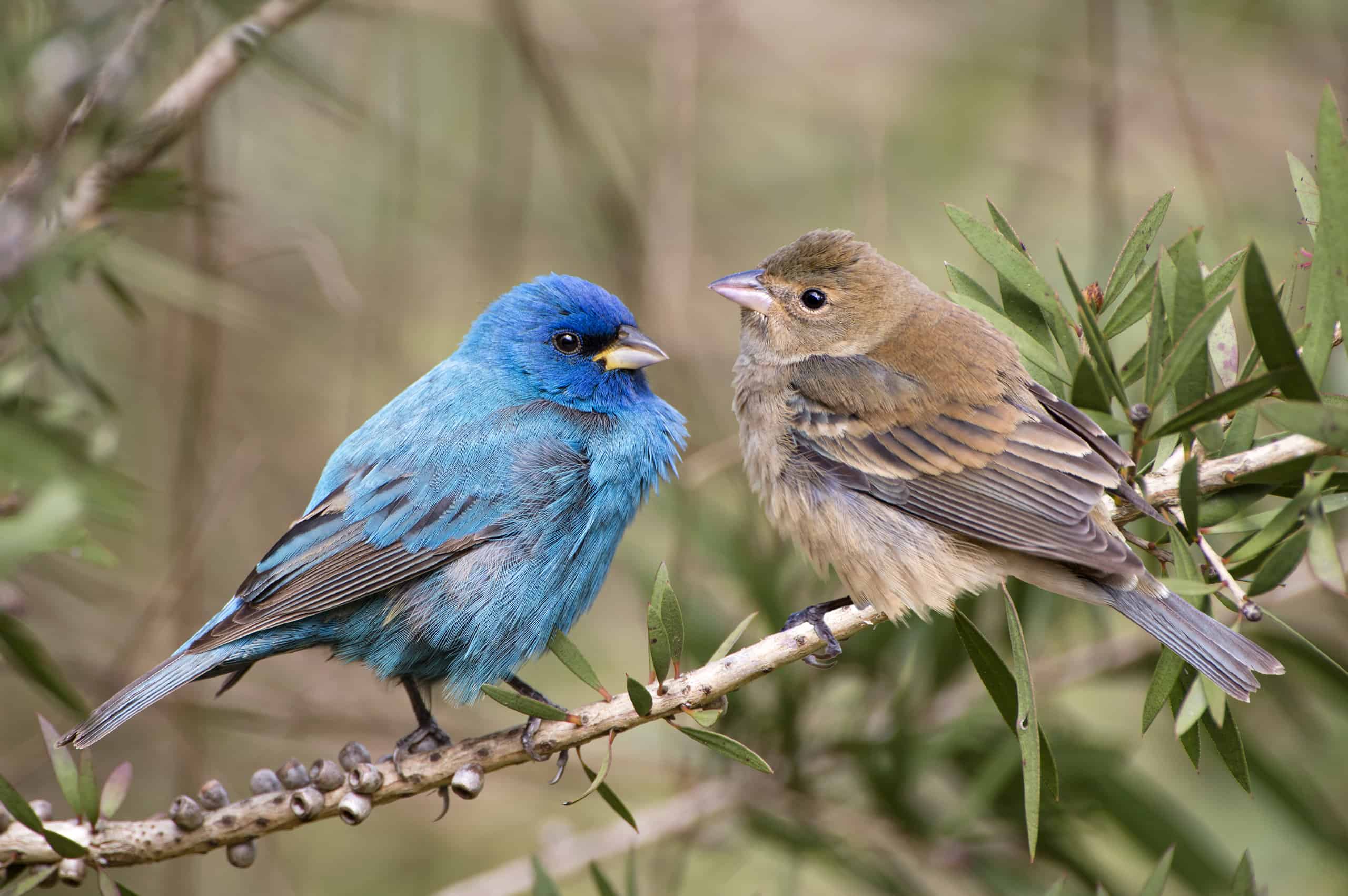Indigo buntings are delightful little birds that are common throughout North America. They live in parts of Canada and the United States throughout their breeding season, but fly south for the winter, moving to the Southern U.S. and on down into Central America. Members of the cardinal family are often seen in woodlands and near farmland. Males are especially visible during the breeding season for their cyan coloration and deep blue faces, though the females are not nearly as colorful. Given their wide distribution and various habitats, it’s fair to wonder: What do indigo buntings eat?

Male indigo buntings especially visible during the breeding season for their cyan coloration and deep blue faces.
©John L. Absher/Shutterstock.com
From indigo buntings’ favorite foods and how they manage to find them, to attracting these captivating little birds to your backyard garden, keep reading!
What Foods Do Indigo Buntings Eat?
Indigo buntings eat berries, seeds, insects, and parts of plants. They are primarily granivores, but will eat many other foods when necessary. Like many other members of the Cardinalidae, indigo buntings have short, conical beaks. This shape is ideal for breaking apart seeds, but it also helps them snatch up insects and pick apart pieces of plants as well.
These birds are not that picky when finding a meal. They are perfectly fine eating grass seeds when they’re available, but they’ll also consume insects for a serving of protein.
A Complete List of What Indigo Buntings Eats
Beyond the mainstays of the indigo buntings’ diet, it’s important to consider some of the more specific foods that these animals will eat. Knowing what these colorful bird eat can inform your choices in attracting indigo buntings to your yard.
Indigo buntings are known to eat many foods, including:
- Millet
- Strawberries
- Elderberries
- Sunflower
- Caterpillars
- Weevils
- Blackberries
- Corn
- Dandelion
- Rice seeds
- Nyjer seeds
- Herbs
- Goldenrod
- Leaves from various trees
- Plant buds
- Wheat
- Various grass seeds
- Spiders
- Beetles
- Cicadas
- Thistle
- Mealworms
Indigo buntings will eat a variety of different foods. Placing any of these foods in your yard will attract all sorts of birds to your property. But, adding the right mix of seeds or growing certain berry-bearing bushes will increase the chances that you will attract indigo buntings to your yard.
Interestingly, this species is not frequently seen drinking. They get most of their water from their diet, which is rich in fluids.
The 20 foods that we’ve listed here are some of foods most commonly eaten by indigo buntings, but it’s nigh impossible to get a complete list of every food they encounter and eat. After all, these adorable little songbirds range from Canada to the northernmost reaches of South America.
How Do Indigo Buntings Find Food?
Indigo buntings use a combination of sight and smell to find and they recognize as food. They can easily cover large distances in their home territory in search of a meal. Indigo buntings are typically ground foragers, but you can also find them in bushes and trees where they find berries and other foods.

Indigo buntings are typically ground foragers, but you can also find them in bushes and trees.
©Bonnie Taylor Barry/Shutterstock.com
These birds have interesting feeding habits. When it’s winter, indigo buntings will flock together to eat food. However, they dine alone during the breeding season. This behavior is seen as a protective measure in the winter and for the sake of getting a reproductive advantage during the breeding season.
What Do Baby Indigo Buntings Eat?
Mature indigo buntings feed their young when they are first hatched. Baby indigo buntings frequently consume insects that their parents bring them. These insects supply protein, which aids their growth. However, these birds do not stay with their parents very long. Fledgling indigo buntings leave their nests about 2 weeks after hatching, typically between 9 and 12 days.

Baby indigo buntings leave the protection of the nest in 9-12 days.
©Liz Weber/Shutterstock.com
Although the female is often responsible for feeding the young, males will take over feeding the young when they are Jon the verge of leaving the nest. Once they leave the nest, young indigo buntings will assume an adult diet.
What Do Indigo Buntings Eat in Winter?
Finding food is a more difficult task in the winter. However, it’s important to keep in mind that many of these birds will move farther south when it gets cold, so, during the winter, indigo buntings are likely to eat berries, tree buds, and various seeds.
Though there is less variety, indigo buntings typically have enough to eat throughout the winter months. When the weather warms up, they will, once again, add plant material and insects to their diet
What Eats Indigo Buntings?
Indigo buntings are small birds, and do not have much in the way of defenses, apart from their size, speed, and senses. They are vulnerable to attacks from a wide variety of predators, including domestic cats, snakes, raccoons, and foxes are but a few of the animals that can kill indigo buntings. Snakes and raccoons will also climb into nests to consume indigo bunting eggs.
Indigo buntings are beautiful birds that can eat a wide assortment of foods including many seeds, insects. Their diet doesn’t change much during the winter months, though it excludes most plant matter and insects. These birds don’t have a very unusual diet, but knowing what they eat can help you draw these birds to your yard to admire their beauty and songs.
Up Next:
Thank you for reading! Have some feedback for us? Contact the AZ Animals editorial team.








